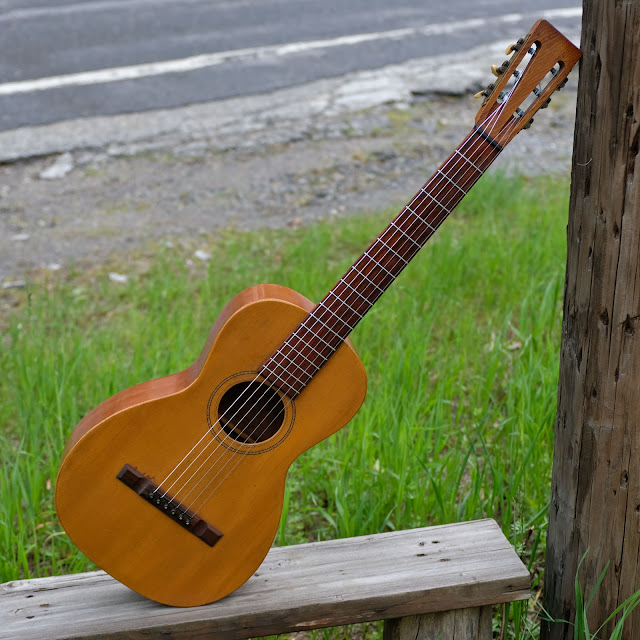1890s Regal-made Arion Parlor Guitar
The owner of this guitar had a hankering for my old L&H Lakeside parlor and while he didn't wind up with that one, he did find this one "in a state" and sent it here for sprucing-up. Like the Lakeside, this one was made by Regal or a pre-Regal entity as it has early Regal trademark features like transverse ladder bracing and a radiused fretboard. It has the Sears "Arion" mark, however, rather than the more-usual (at least more-usual to me) Lakeside or Lyon & Healy branding.
The owner has been doing his research homework and has concluded much the same as I had before regarding the Lakeside versions -- that these have to be "Regal-made" but the timeframe is earlier (late 1880s/1890s) than Regal's official incorporation in its early, Indianapolis-based format.
This guitar's construction is what makes it totally enticing -- these little guitars just have it. The bracing (one ladder brace below and one ladder brace above the soundhole... with the the one below set at a 30-40 degree angle) opens up a sweeter bass response and gives it a fuller, more natural tone compared to the average parlor of the time which can be a little stuffy. It's also built incredibly light and feels almost like an oversized, quality baritone ukulele in the lap. This model also has the simplified looks (colorful but understated rosette, no binding) that give it an arts-and-crafts appearance.
Its top is solid spruce, its back and sides are a creamy-colored mahogany of the sort you see on very old cigar boxes, the neck is Spanish cedar and the fretboard and bridge are rosewood. You can see the earliest incarnation of the L&H-type "flattened-pyramid" bridge shape on these, too, when they're still extant (the ebonized maple ones always split).
Clearly, a pin-bridge guitar from this time was intended for gut strings, but I've had a lot of success "modernizing" the vibe of these little pseudo-classical instruments by using the hybrid classical Thomastik KR116s, which is what this one's wearing. It would sound great with typical nylon, however (and I did adjust the nut to take nylon gauges as well), though I really do like the precision and more steely-sounding treble response of these strings.
Work included a neck reset, bridge reglue, fret level/dress, lots of brace regluing to the top and back, hairline crack repairs on the top, some oversize side-dot installs, popsicle brace reinforcement under the fretboard extension, a new ebony saddle (per customer request, though the original bone one is still good to go and on-hand), and a replacement set of ebony pins. It's playing perfectly and has a straight neck.
Specs are: 24 1/4" scale, 1 13/16" nut width (though it feels like 1 3/4"), 1 9/16" string spacing at the nut, 2 11/32" spacing at the bridge, 11 5/8" lower bout width, 8 1/4" upper bout, 3 5/8" depth at the endblock, 12" fretboard radius, and 3/32" EADG and 1/16" BE action at the 12th fret. I usually leave action at 3/32" across the board for nylon, but these strings can get the lower 1/16" on the treble side and still remain clean-sounding. The original saddle can be swapped-in for 3/32" overall if nylon/standard classical strings get used later-on.
For something between size 1 and size 2 per Martin specs, this guitar dishes-out a great sound. It's a little brighter and more up-front than the oak-backed versions, but quite sweet.
The original ebony nut is still extant. I also love the way the grain in the Spanish cedar neck pops-out at the headstock.
These oversize pearl dots were by request of the owner. I filed them flush with the neck so they actually have a bend in them as they progress into the "meat" of the neck and out of the fretboard. The neck has a C/V hybrid shape to its rear.
Isn't the rosette excellent? It has green/red/yellow/black bits making it up.
The original bridge is in excellent shape. My only frustration is that it'd been reglued in the past and with some obnoxious glue that'd caked to the bottom in 1mm or so layer. When I began to take it up (it was almost off), it popped-off quickly and took a thin slice of mostly-finish-chips at the front of the bass side along with that old glue. Sigh...
The black line in front of the bridge is an old hairline crack that's been cleated and is good to go. The new ebony bridge pins are pearl-dotted and freebies from my parts-bins. The original rosewood pins in this guitar had tiny pearl dots (in the few remaining), so I figured I'd keep the look.
Note the low profile of the saddle: that's how these guitars were engineered when made. When I reset the neck, I set it so that it'd give me 3/32" action overall with the original, unmolested saddle in place. I did add the modern convenience of mild string-ramping behind the saddle, though, for better tone.
The original endpin is pearl-dotted, too.






















Comments
The Arion guitar was sold to me by Billy Voiers in around 1973 in Williamstown, MA when I was a student there - and also met Bill Cumpiano and Harry Becker - Stringfellow and they were known at the time, now In Northampton, MA. Bless you for posting this wonderfully complete rundown on the Arion parlor guitar. I recently lent it to Justin Osowiecki, my son-in-law’s brother and an accomplished player and songwriter. He liked its strength but understated timbre.